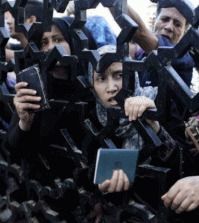Any views expressed in this article are those of the author and not of Thomson Reuters Foundation.
Rape in conflict is almost never prosecuted. But a newinternational protocol for investigating and documenting such crimes aims to change this harrowing fact. Unveiled at the Global Summit to End Sexual Violence in Conflict last month in London, the document includes practical steps for interviewing witnesses, photographing and sketching crime scenes, and collecting personal data from survivors. Summit co-chair and U.K. Foreign Secretary William Hague (replaced this week by Philip Hammond) is promoting the protocol as part of a new global effort to “shatter this culture of impunity.” Developed over the last two years in consultation with more than 100 experts worldwide, the protocol offers three essential opportunities.
First, it acknowledges the critical role that local actors play in supporting survivors and enforcing justice at the community level. The protocol offers guidance on more effective ways of gathering court-admissible evidence and offers detailed instruction for those who interact with survivors from the time of the incident through a justice process.
Sexual violence cases are some of the hardest to prosecute because evidence is often insufficient. Criminal investigations are often weak to non-existent and documentation is frequently incomplete or inaccessible. Prosecutors often lack the political courage required to pursue powerful perpetrators. The recent judgment in the Minova trial in the Democratic Republic of the Congo is a case in point. Forty soldiers and officers were charged with crimes against humanity and war crimes – including rape, murder, and pillage – after a U.N. investigation found that at least 126 women and girls were sexually violated by Congolese military. Despite more than 43 women courageously testifying in the proceedings, only two low-ranking soldiers were convicted of rape.
These judgments are demoralizing for survivors who put themselves at great risk of reprisal. But judges are often forced to adjudicate these cases without hard evidence that would validate the survivors’ experience.
The protocol aims to better equip local clinicians and law enforcement to conduct comprehensive medical evaluations and police investigations. It standardizes methods for collecting and analyzing evidence by human rights researchers and criminal investigators and urges them to refer their cases to local clinicians for forensic medical exams. The prosecutions will not only bring survivors the justice they deserve, but also serve as a potential deterrent against future violence.
The protocol’s second critical contribution is that it encourages first responders to think about their roles in a larger, multi-sectoral context. Most doctors and nurses see their jobs as providing medical care, and don’t think of, or haven’t been trained to collect forensic medical evidence to potentially support prosecutions.
But when police officers, lawyers, and judges understand the value of forensic medical evidence, they can better evaluate the opportunities of submitting this data to court. Responding to sexual violence is so challenging that all experts must work in concert with survivors to overcome the hurdles – no one sector can do it alone.
Finally, the protocol highlights the critical responsibility of practitioners to “do no harm” or minimize the harm they may inadvertently bring to the survivors, their families, or witnesses. Many survivors and witnesses experience intense intimidation, retaliation, and threats by perpetrators and their families, and some are even killed. The protocol places survivors’ safety and security at the center of the process. There is an understanding that cases will fail without serious attention to witness protection.
The protocol is a necessary step for building systemic change, but it is only the beginning. It is based on international legal principles, but must be adapted to take local law, customs, and resources into account. Local doctors, police officers, lawyers, and judges must still be trained and mentored.
At Physicians for Human Rights, our Program on Sexual Violence in Conflict Zones has been providing this multi-sectoral forensic training in Eastern Congo and Kenya since 2011. During these trainings, Kenyan police officers lament their lack of access to transport or funds for fuel to travel to crime scenes or apprehend a suspect even when they know his whereabouts. Congolese doctors and nurses have confided to me that they frequently receive threatening calls and text messages in the middle of the night.
Nevertheless, we are beginning to see the promise and power of the multi-sectoral model. Following our training, doctors leave with contact details for trusted police officers they can call for help. Police connect with clinicians they can reach out to when they have a new case. As one senior judge from Congo recently explained, “Even though we have imperfect law, we can still make a difference by working together.”
Strengthening justice mechanisms is an ongoing process. By encouraging deeper collaboration across medical and legal sectors, we will begin to write the next chapter for survivors of sexual violence. Those who have suffered these heinous crimes deserve nothing less.
Karen Naimer is Director, Program on Sexual Violence in Conflict Zones, Physicians for Human Rights





